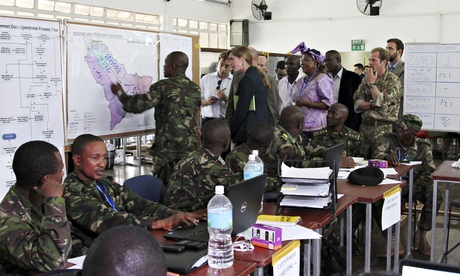Low HIV and Aids rates saw west Africa ‘miss out on health investment’
The Guardian, 29 October 2014 - Ebola-hit region failed to secure substantial foreign aid in earlier epidemic, study says, and was unable to improve health systems.

West Africa, now in the throes of a calamitous Ebola epidemic, missed out on significant health investment over the past decade or more because it had low rates of HIV, a detailed survey of the changing health of Africa and Asia reveals.
A major project called Indepth, which has looked at the causes of death of more than 110,000 people in 13 countries shows that health improved generally in those given substantial international aid to try to turn around the HIV and Aids epidemic. But west Africa, with severe poverty and low healthcare standards but relatively little HIV, did not benefit.
“In most parts of Africa, health systems have been strengthened by the external funding of HIV,” said Dr Jimmy Whitworth, head of population health at the Wellcome Trust which funded the project. Pepfar (the US President’s Emergency Plan for Aids Relief) and other agencies invested in health clinics and staff in order to make it possible for thousands of Africans in Aids and HIV-hit countries such as Kenya to be tested and given antiretroviral drugs to keep them alive and well.
“There was a view at one stage that HIV care would crowd out other illnesses and they would get worse,” said Whitworth – but that did not happen. Instead, healthcare became a higher political priority in countries such as Rwanda and Kenya and improved across the board over time.
But no such improvement occurred in Sierra Leone, Liberia or Guinea. “In west Africa it is most stark,” said Whitworth. “I used to work in Sierra Leone in the late 80s. The health services were pretty poor at that time. Since then, they have gone through civil war with everything collapsing. They have been rebuilding since the civil war ended so some improvement has been made, but I don’t think the health systems have been strengthened very much.”
Just as Aids focused minds and money 15 years ago, so Ebola should now. Whitworth said he hoped that as healthcare in west Africa now had the world’s attention, it could keep it. “Otherwise we’re left as a global community with a real achilles heel with inadequate services,” he said.
The Indepth project is an unprecedented exploration of the causes of death in communities where no records are kept. Hundreds of researchers carried out interviews over two decades to establish how people died. They conducted verbal autopsies, interviewing family members in a structured way about the illness and last days of the deceased. The data, collected in 22 sites, each containing around 100,000 people, were then computer processed to establish the likely cause of death.
Most studies that publish death rates from diseases around the world use official figures from hospitals, but deaths in rural villages are missed and there are no death certificates issued in rural Africa.
The data comes to similar conclusions to the Global Burden of Disease study on the toll taken by malaria, TB, HIV and maternal and child mortality. But it shows a great deal of variability between one region and another - and investment in healthcare appears to be a factor.
Deaths of women in pregnancy and labour and child deaths are consistently high across Africa and Asia. Children’s drownings in Bangladesh and homicide among adult men in eastern and southern Africa are also causes for concern, the authors say.
The data is being published in a special issue of the journal Global Health Action, which is open access.
